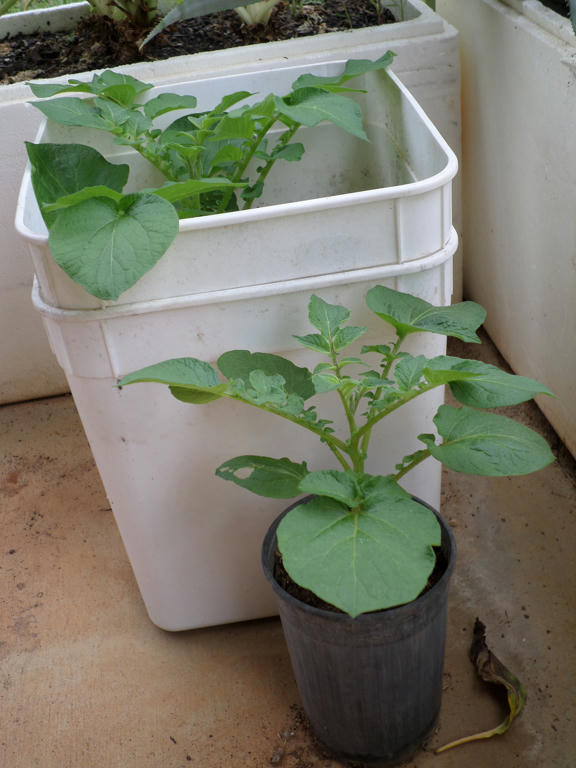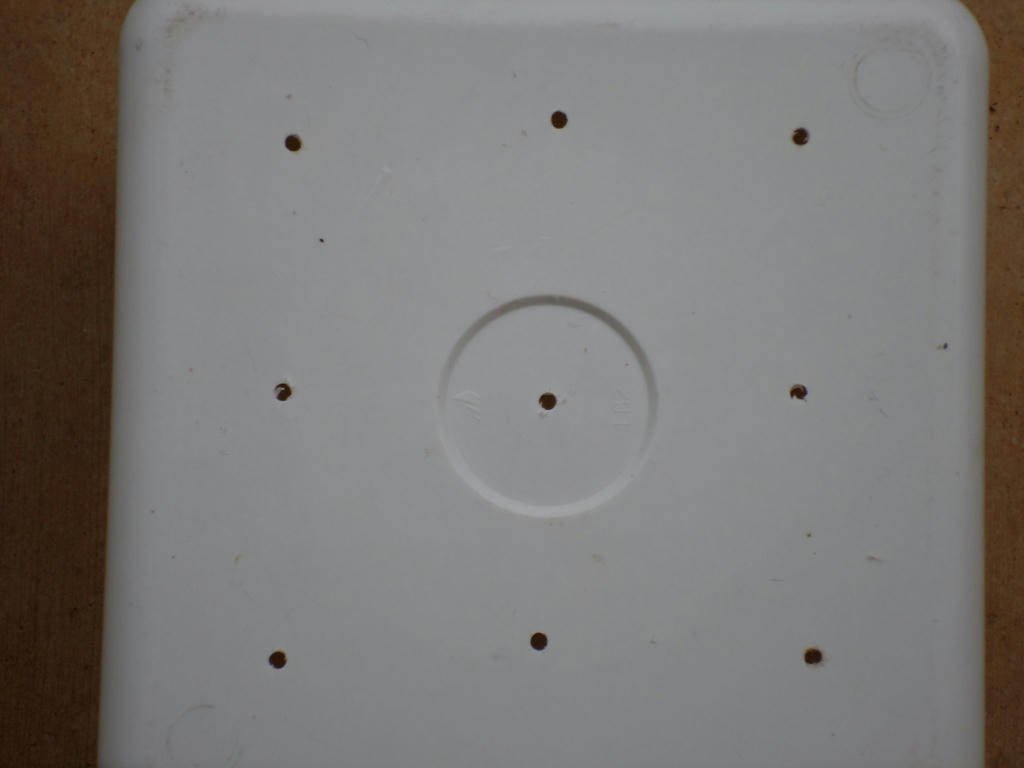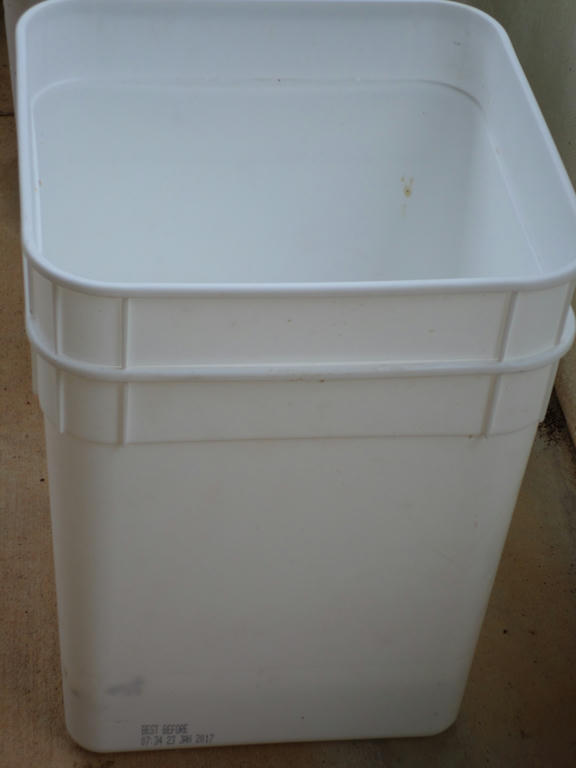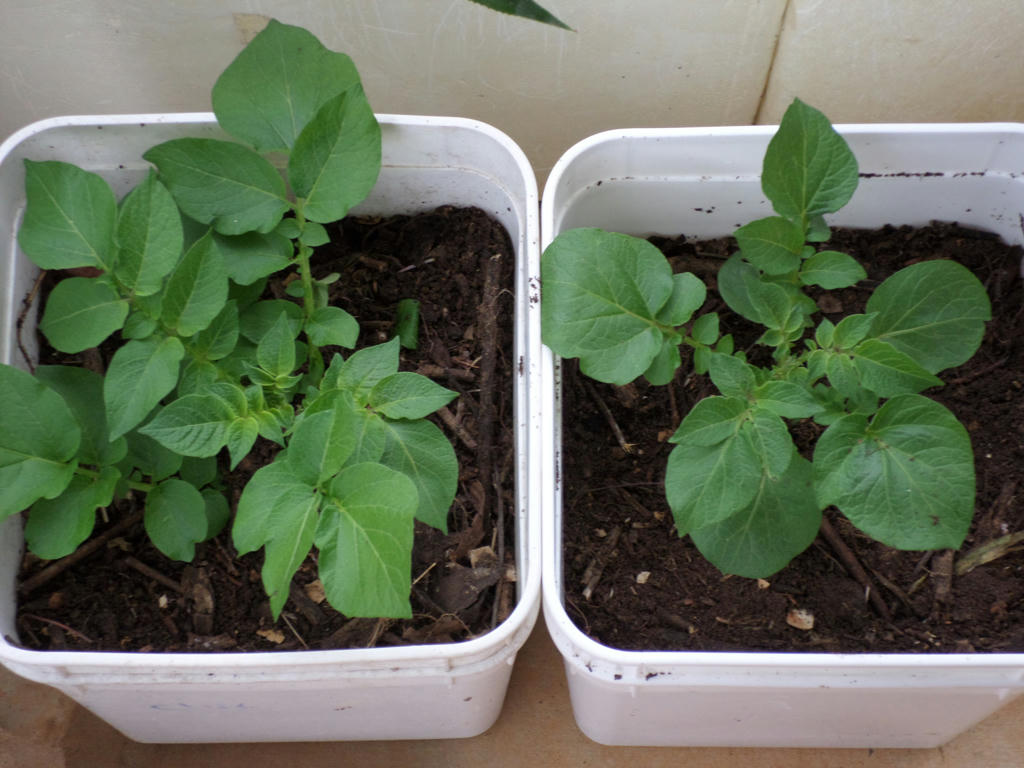Photo taken 2014
I haven't had much luck growing potatoes here. I'm putting it down to a lack of experience and unsuitable conditions. I tried to remedy that back in May 2014, where I did a potato experiment - transplanting a volunteer from the compost into a wheelbarrow.
Since you haven't heard me bragging about copious amounts of potatoes, you can assume (as I know) that particular experiment failed. As predicted, the wheelbarrow was too dry and hot, and ended up frying the volunteer in summer.
New experiment in 2015
But you know I'm such a glutton for punishment. Plus, I hate wasting green potatoes which have sprouted in the pantry, so I'm experimenting once again.
Only this time I'm resorting to containers. Recycled ice-cream containers from my husband's work, to be precise. They're 10 litres in volume, and I set one inside another, to act as a sort of wicking bed. Which I'll explain shortly.
In the above picture however, I started with chitted potatoes - three were planted inside the ice-cream container, and one inside a regular pot.
Ready to transplant
Of the three segments I placed in the ice-cream container, only one sprung up. A second one attempted to, but the well developed, first plant, shaded it out and ensured it remained stunted. The potted potato did really well though and had great root structure, as seen above.
I wanted to transplant it into another set of ice-cream containers, which we never run out of, as David brings home the kitchen scraps from his workplace, for the chickens, in these plastic tubs. They would otherwise be put in the recycle bin, but I'm going to try and grow potatoes in them instead.
Minor preparation
First, I had to drill some holes in the base of one container. I drilled about nine, for adequate drainage. Then I set the container with holes, inside the other container - without holes.
Ready for soil
This is going to act like a wicking box, as the bottom container will catch any excess moisture and hold it, but the first container will drain freely.
The benefit of these containers are, I intend to add more as the potato plant continues to grow upwards. I'll just cut the base off the next container, and stack it within the existing ones.
Sweet!
I now have two potato plants, which will hopefully produce some potatoes. Its not exactly the right time for potatoes in the garden, as we're in autumn now, but I'll keep these tubs protected by keeping them on the concrete verandah.
It receives the afternoon sun so frost shouldn't be a problem in winter.
Fingers crossed, by Spring, I'll be harvesting potatoes!!






I can see a problem straight away (if I'm understanding this correctly?). The container on the bottom, without any holes....there's no way for water to drain away, so water can potentially build up right to the rim of the container inside it, which will mean permanently saturated soil in that top container. I would be drilling a hole in the side of the bottom container about a third to halfway up, so that doesn't happen but there's still enough water in the bottom container to wick up into the soil in the top container.
ReplyDeleteSo now, if I'm getting this right, you're going to add a third container on the top (with no bottom) around the potato and fill it will more soil as the potato grows, and so on? But water will only wick up against gravity about 30 cm, so I'd expect, if you go above that level, the top part of the growing medium will remain dry.
Have I understood what you're doing or am I seeing it wrongly? I'm interested in how it goes, because I've never thought of planting potatoes in a wicking box before.
You read that all correctly. I was thinking about the bottom getting full with water, but was going to be careful which how much water I applied. Drilling side holes in the bottom container, sounds like a better way to go. So I'll take that idea and run with it, okay, lol. ;)
DeleteThanks. :)
Only wicks to the first 30cms huh? I didn't know the specifics, but its good to learn now. Your insight is appreciated. I was hoping the roots of the upper potatoes would grow down to the water. From what I saw on the potted potato, the roots are pretty formidable.
I'll be watering from the top of the container anyway, so it shouldn't dry out. It's not an exact model of wicking, but will ensure some protection on the days I don't get around to watering. A little bit at the bottom will be better than drying out completely.
I'm sure you could do a better job of wicking potatoes than me, as you have more experience with it. I'll be happy if mine live, lol. If you get any rogue potatoes in the pantry though, you should set up a wicking box experiment, with what you have available. We can experiment together. :)
I probably would have tried before, but my wicking boxes are only 25 cm deep and I don't think it would be deep enough as I usually heap up soil or mulch around the stems as they grow. I've done leeks in wicking boxes before and I heap up mulch around the stems to keep them white, but in that case I put a wire 'fence' around the top of the box and that kept the heaped-up stuff confined. Plus, I can grow potatoes successfully in the garden, which is another reason why I haven't bothered with wicking boxes. It would still be nice to know if it works, though.
DeleteThis is where I got my original info about wicking beds from, including (I think) the bit about water only wicking up 30 cm.
http://waterright.com.au/wicking_bed.htm
I've seen that website before, but it changed its information which was harder to read, so I haven't gone back to it. I will again though, in case they've made it easier to read. Thanks for the recommend.
DeleteI wouldn't bother with pots either, if you can do a better job in the ground. :)
I really like the idea of these buckets as wicking beds. I was thinking that if I did try tomatoes (serious blight in the area right now) I'd do it in containers like this. We have 5 gallon buckets though I love these ice cream pales
ReplyDeleteAs to potatoes, we have tried a few methods and nothing produces as well as good old fashioned planting. However, we got tired of getting damaged spuds when digging them out so we tried straw last year with good effect. I think that good stock is important too for a start. Get some good seed spuds and you should do okay-from a gardening store. I don't know that potatoes in a grocery store are acclimated to my region so I avoid them. Instead I grow a crop and save some back for replanting. That is also how we grew our garlic-good seed stock for a start but we are on 4th generation after the initial investment. Sometimes this investment pays as it saves time and effort.
To clarify, I grow a crop from seed potatoes and save some back-they don't seem to produce generation after generation like garlic does-we might get 2 years out of the one investment.
DeleteI can see tomatoes doing well in pots. :) We have tried buying good seed potatoes before, but they die just as well as the store bought ones, lol. I think we lack the moisture in the soil which potatoes like. They tend to die in our dry springs. I try and keep water up to them, but I think getting stressed, all the pests start moving in, eat the leaves and then they just cark it!
ReplyDeleteBut if you can do it the old fashioned way, it sounds like the best way to grow potatoes.
You reminded me, I have to plant my garlic today - and I mean it, lol. I've been saying that for the past few weeks, but I don't have the ground prepared yet. I think I'll just put them in a styrafoam box!
It might be the moisture or the ph or even the content of your soil. In this area, the potato farms are further north than here. I don't see irrigation but the soil color when plowed is more brown than our black earth is in this area. The farmers up north also tend to do irrigation so I am thinking from these things that they may have sandy soils where we have more clay in ours.
DeleteThe old fashioned way is perfect but as I said, spearing the spuds when digging them out is not good (I have dehydrate them rather than store them if we don't eat them right away so more work) so the straw method is the one we will continue with.
Our garlic is emerging! And we are still eating from last years haul. I hope yours grows abundantly!
Ugh again to clarify-the farmers up north who don't grow pototoes irrigate but I've never seen the potato fields irrigated but they might be as they do seem more prone to drought. I am now officially curious as to how to grow great potato!
DeleteI reckon you're onto something with those sandy soils up north, because too much moisture and then you get fungal problems. I suspect if I plant my potatoes in autumn, instead of spring, I might end up with survivors - because that's when we actually get rain but not the intense heat to create mould.
DeleteIf my pumpkins. luffa's and (in the past) zucchini, were prone to be killed during summer due to leaf mould, my potatoes wouldn't fair any better. I've only just made the correlation though, because at least some of the plants I mentioned above would re-shoot and take off again, but the potatoes were always wiped out.
I'm with you about learning how to grow the great potato, because they're a nutrient dense food which stores well. Worth the effort!
We get that leaf mold here on the pumpkin and the zuchinni but it doesn't affect the vegetables. Its not something that is considered horribly harmful in our area actually-its expected to hit near the end of the harvest of each plant. But I did grow luffa on a trellis and didn't see mold on the leaves so that is another issue too-air circulation. Like most things, I think I'll go find out from the Amish regarding how to best grow potatoes. I will let you know.
Delete